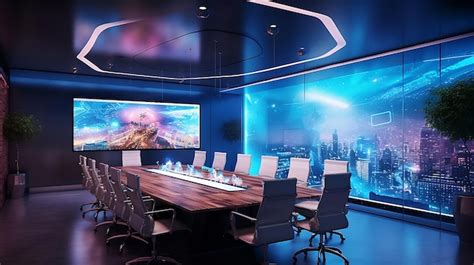The modern workplace has undergone a significant transformation in recent years, with technology playing a crucial role in shaping the way we work. One area that has seen tremendous innovation is the meeting room. Gone are the days of traditional, static meeting spaces. Today, high-tech meeting rooms are revolutionizing the way teams collaborate, communicate, and make decisions.
The Importance of Effective Collaboration
Effective collaboration is the backbone of any successful organization. When teams work together seamlessly, they can achieve remarkable results. However, traditional meeting rooms often hinder collaboration, with outdated technology, inadequate space, and lack of engagement. This is where high-tech meeting rooms come in – designed to facilitate seamless communication, foster creativity, and drive productivity.
The Evolution of Meeting Rooms
The concept of meeting rooms has undergone a significant transformation over the years. From traditional conference rooms to modern, high-tech spaces, the evolution has been driven by advances in technology and changing workforce demographics.
- Traditional Meeting Rooms: These rooms were often characterized by static furniture, limited technology, and a formal atmosphere. They were primarily used for presentations, meetings, and training sessions.
- Modern Meeting Rooms: With the advent of technology, meeting rooms began to incorporate basic audio-visual equipment, such as projectors and screens. This marked a significant improvement, but the spaces were still largely static and lacked interactivity.
- High-Tech Meeting Rooms: The latest generation of meeting rooms is designed to facilitate seamless collaboration, communication, and creativity. These rooms are equipped with cutting-edge technology, flexible furniture, and innovative design elements.
Key Features of High-Tech Meeting Rooms
So, what sets high-tech meeting rooms apart from their traditional counterparts? Here are some key features that make these spaces truly revolutionary:

- Advanced Audio-Visual Equipment: High-tech meeting rooms are equipped with state-of-the-art audio-visual equipment, including high-definition displays, surround sound systems, and advanced projection technology.
- Collaboration Tools: These rooms often feature interactive whiteboards, touch-sensitive displays, and collaboration software that enable teams to work together seamlessly.
- Flexible Furniture: High-tech meeting rooms often feature modular, flexible furniture that can be easily rearranged to accommodate different meeting styles and configurations.
- Smart Building Technology: Many high-tech meeting rooms are integrated with smart building technology, enabling features such as automated lighting, temperature control, and energy management.
- Virtual and Augmented Reality: Some high-tech meeting rooms incorporate virtual and augmented reality technology, enabling teams to engage in immersive, interactive experiences.
Benefits of High-Tech Meeting Rooms
The benefits of high-tech meeting rooms are numerous, with some of the most significant advantages including:
Enhanced Collaboration and Communication
High-tech meeting rooms are designed to facilitate seamless collaboration and communication. With advanced audio-visual equipment, collaboration tools, and flexible furniture, teams can work together more effectively, share ideas, and make decisions.
Increased Productivity
High-tech meeting rooms can significantly boost productivity, as teams can work more efficiently, access information quickly, and collaborate in real-time.
Improved Creativity and Innovation
High-tech meeting rooms can foster creativity and innovation, as teams are empowered to think outside the box, explore new ideas, and experiment with new technologies.
Enhanced User Experience
High-tech meeting rooms can provide an exceptional user experience, with features such as comfortable seating, natural light, and advanced technology that enhances the overall meeting experience.
Best Practices for Implementing High-Tech Meeting Rooms
Implementing high-tech meeting rooms requires careful planning, design, and execution. Here are some best practices to consider:
Assess Your Needs
Before designing a high-tech meeting room, it's essential to assess your organization's specific needs and requirements. Consider factors such as meeting frequency, team size, and technology requirements.

Design for Flexibility
High-tech meeting rooms should be designed to accommodate different meeting styles and configurations. Consider using modular furniture, flexible layouts, and advanced technology that can be easily adapted to meet changing needs.
Invest in Advanced Technology
High-tech meeting rooms require advanced technology that can facilitate seamless collaboration, communication, and creativity. Consider investing in state-of-the-art audio-visual equipment, collaboration software, and smart building technology.
Provide Training and Support
To ensure that teams can effectively utilize high-tech meeting rooms, it's essential to provide comprehensive training and support. Consider offering workshops, tutorials, and online resources that can help teams get the most out of these spaces.
Monitor and Evaluate
Finally, it's crucial to monitor and evaluate the effectiveness of high-tech meeting rooms. Consider collecting feedback from users, tracking usage patterns, and assessing the impact on productivity, collaboration, and innovation.
Gallery of High-Tech Meeting Rooms






FAQs
What are the benefits of high-tech meeting rooms?
+High-tech meeting rooms can enhance collaboration and communication, increase productivity, foster creativity and innovation, and provide an exceptional user experience.
How can I design a high-tech meeting room?
+When designing a high-tech meeting room, consider assessing your organization's needs, designing for flexibility, investing in advanced technology, providing training and support, and monitoring and evaluating the space.
What technology should I consider for my high-tech meeting room?
+Consider investing in state-of-the-art audio-visual equipment, collaboration software, and smart building technology that can facilitate seamless collaboration, communication, and creativity.
In conclusion, high-tech meeting rooms are revolutionizing the way teams collaborate, communicate, and make decisions. By incorporating advanced technology, flexible furniture, and innovative design elements, these spaces can enhance productivity, foster creativity and innovation, and provide an exceptional user experience. Whether you're designing a new meeting room or upgrading an existing one, consider the best practices outlined in this article to create a high-tech meeting room that truly supports your organization's needs.
